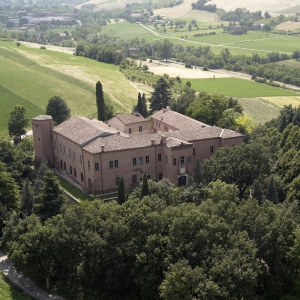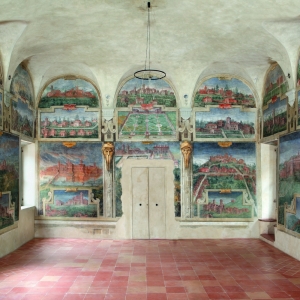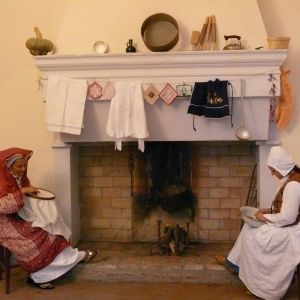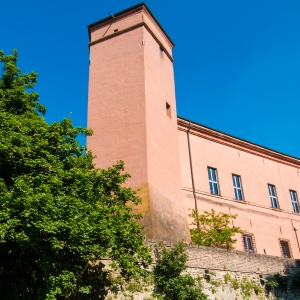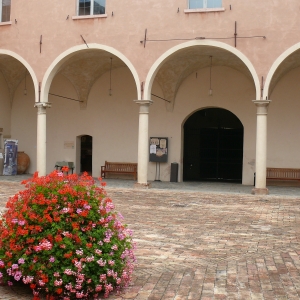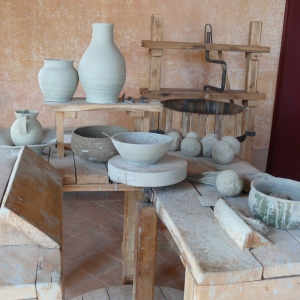In the late medieval period, under the lordship of the Da Spezzano and later Da Castello families, it probably had an initial fortified wall, a keep, one or two towers, a few dwelling houses, a well, granaries and storehouses for crops. The entrance, to the north, was via a drawbridge after the introduction of the moat in the 14th century. A place of defence and refuge for the population, Spezzano succeeded during the wars of the 14th century in resisting attacks and sieges, such as that of 1355, during which the Este troops were unable to conquer it and take it from the Visconti family, who had dominion over it. Open-air archaeological area: during restoration work, the remains of a cistern for collecting water emerged, built next to the south-west tower destroyed by the earthquake of 5 June 1501: "a Spezan si è caschà la tore dove steva il podestà".
The Pio Palace of Savoy - El palazo di Spezan
In 1395, Marquis Alberto d'Este granted the castle as a feud to Marco Pio, lord of Carpi. In the early 16th century, Alessandro Pio di Savoia reorganised the State of Sassuolo, establishing one of the five podestà seats in the castle of Spezzano. With the rule of the Pio di Savoia family, the castle became the lord's residence and political, administrative and legal centre, losing the characteristics of the medieval fortress. In the first decades of the 16th century, in fact, on the very 'walls' that surrounded the castle in the west and north, construction of the Pio palace began, at the behest of Enea Pio in 1529. On the ground floor, in the last room of the west wing, there is a wooden ceiling decorated with polychrome tiles with heraldic coats of arms, the initials of Aeneas Pius and the date 1531, which can be considered the end of the first phase of construction of the palace, which also includes the Gallery of Battles and, in the Old Apartment, known as the flat of Clelia and Marco, the room with the marriage coats of arms. The Galleria delle Battaglie (Battles Gallery) is frescoed with important battles of the 16th century involving Alfonso I d'Este the 'artillery duke' and the condottieri of the Pio and Este families. Work resumed in 1587, when Marco III Pio was granted the State of Sassuolo: the architraves painted in gilded letters with the inscription "Marcus Pius de Sabaudia Saxoli dominum et cetera" on the ancient doors of the first floor and the extraordinary Hall of Views on the ground floor.
The Hall of Views - Salla de Stati
Towards the end of the 16th century, Marco III Pio (1567-1599), the last, restless lord of the autonomous state of Sassuolo, had a portrait of the salient places of his dominion painted between 1595 and 1596 in the main hall of the Spezzano castle: a sequence of no less than 56 views that included the most minute corners of his fiefdom, made up of the Modenese possessions and those in Sabina, received in 1595 as a dowry debt from his wife Clelia Farnese, whom he married in 1587. The great hall was thus decorated by Cesare Baglione, a court painter of the Farnese family of Parma, an exponent of Bolognese Mannerism, specialised in landscape painting, with a pictorial cycle celebrating the power of the Pio di Savoia family through the representation of castles, towns and villages, from the plains to the mountains, belonging to the Pio State, divided into five podesterie: Sassuolo, Spezzano, Formigine, Brandola and Soliera. The cycle of frescoes concluded in the vault of the room with the depiction of a crowned woman, personification of Pietas, bearing the quartered shield of the Pio family and the motto "Pia Soboles", the Pia dynasty. Halfway between painting and cartography, the depictions are valuable historical testimonies and offer the possibility of grasping the characteristics of the urban and suburban structures of individual localities.
The Seigniory of the Coccapani Marquises
After the death of Marco Pio di Savoia in 1599, after a brief period of rule directed by the Este family, in 1629 the fief and castle of Spezzano passed to Marquis Guido Coccapani until 1796. During this period, the castle also played the role of a venue for community meetings. In the chamber known as 'della Ragione', the Council met in the presence of the podestà to elect the regents and officers of the municipality and to deal with the affairs of the Spezzano community. Inside the castle there was a tribunal or Praetorium, where the podestà sat to administer justice and, next door, the rooms used as the residence of the jusdicente. There were also the prisons, four in number, located at the bottom of the two towers, on the southern side and inside the podestà's residence. In the courtyard, especially in the 18th century, the so-called pavaglione, i.e. the market for 'follicelli' or silkworms, took place.
shorten


